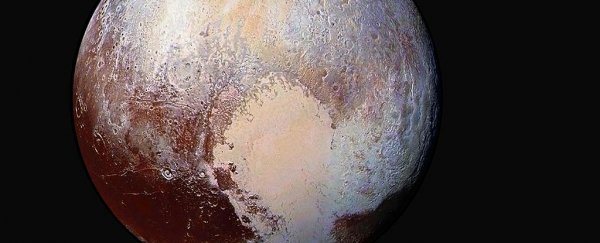Pluto's geography now has officially approved names, so if you get lost on the way to the ice plains, you'll be able to ask for accurate directions.
Actually, the naming of planetary features is very serious business. Only the International Astronomical Union's Working Group for Planetary System Nomenclature has the authority to approve them, and they usually follow certain conventions.
Names take a bit of time to formalise, which is why we have the first official 14 names two years after probe New Horizons flew by Pluto in July 2015. It's not a contentious process, though - some are the names the New Horizons team has been using since the beginning, others are suggestions made by members of the public.
"We're very excited to approve names recognising people of significance to Pluto and the pursuit of exploration as well as the mythology of the underworld. These names highlight the importance of pushing to the frontiers of discovery," said the IAU's Rita Schulz.
"We appreciate the contribution of the general public in the form of their naming suggestions and the New Horizons team for proposing these names to us."
Naming these features will allow researchers in the future to accurately pinpoint and describe locations, but they also help honour the contributions of scientists and other Pluto pioneers.
Clyde Tombaugh, the astronomer who discovered the dwarf planet, and Venetia Burney, the 11-year-old girl who proposed the name Pluto, have both been honoured.
"The approved designations honour many people and space missions who paved the way for the historic exploration of Pluto and the Kuiper Belt, the most distant worlds ever explored," said New Horizons principal investigator Alan Stern.
More features will be named on Pluto and its moons in the future, and life isn't over for New Horizons, either, which is expected to make a flyby of Kuiper Belt object 2014 MU69 in January 2019.
 International Astronomical Union
International Astronomical Union
Here's the full list of names, according to the IAU website:
Tombaugh Regio honours Clyde Tombaugh (1906–1997), the U.S. astronomer who discovered Pluto in 1930 from Lowell Observatory in Arizona.
Burney crater honours Venetia Burney (1918–2009), who as an 11-year-old schoolgirl suggested the name "Pluto" for Clyde Tombaugh's newly discovered planet. Later in life she taught mathematics and economics.
Sputnik Planitia is a large plain named after Sputnik 1, the first space satellite, launched by the Soviet Union in 1957.
Tenzing Montes and Hillary Montes are mountain ranges honouring Tenzing Norgay (1914–1986) and Sir Edmund Hillary (1919–2008), the Indian/Nepali Sherpa and New Zealand mountaineer who were the first to reach the summit of Mount Everest and return safely.
Al-Idrisi Montes honours Ash-Sharif al-Idrisi (1100–1165/66), a noted Arab mapmaker and geographer whose landmark work of medieval geography is sometimes translated as "The Pleasure of Him Who Longs to Cross the Horizons."
Djanggawul Fossae defines a network of long, narrow depressions named for the Djanggawuls, three ancestral beings in indigenous Australian mythology who travelled between the island of the dead and Australia, creating the landscape and filling it with vegetation.
Sleipnir Fossa is named for the powerful, eight-legged horse of Norse mythology that carried the god Odin into the underworld.
Virgil Fossae honours Virgil, one of the greatest Roman poets and Dante's fictional guide through hell and purgatory in the Divine Comedy.
Adlivun Cavus is a deep depression named for Adlivun, the underworld in Inuit mythology.
Hayabusa Terra is a large land mass saluting the Japanese spacecraft and mission (2003–2010) that returned the first asteroid sample.
Voyager Terra honours the pair of NASA spacecraft, launched in 1977, that performed the first "grand tour" of all four giant planets. The Voyager spacecraft are now probing the boundary between the Sun and interstellar space.
Tartarus Dorsa is a ridge named for Tartarus, the deepest, darkest pit of the underworld in Greek mythology.
Elliot crater recognises James Elliot (1943–2011), an MIT researcher who pioneered the use of stellar occultations to study the Solar System - leading to discoveries such as the rings of Uranus and the first detection of Pluto's thin atmosphere.
The news was announced in a statement on the International Astronomical Union website.
